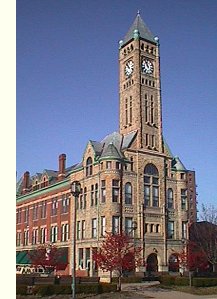 Clark County, Ohio has a unique, charming, and informative Historical Center housed in the unique and charming former farmer’s market. It also has more than its fair share of “reenactors.”
Clark County, Ohio has a unique, charming, and informative Historical Center housed in the unique and charming former farmer’s market. It also has more than its fair share of “reenactors.”
Part of that has to do with the nationally-known Fair at New Boston, a historical reenactment of an early 19th-century trade fair, held the Saturday and Sunday before Labor Day every year at George Roger’s Park, about three miles west of Springfield. The park is the site of Tecumseh’s birthplace, of one of the first white settlements in Western Ohio, and of the “Battle of Piqua,” which – contrary to numerous Ohio History texts – did not take place near the modern Ohio town of Piqua.
In addition the Clark County Historical Society/Heritage Center has a number of volunteers who periodically show up in costume to act as docent to museum visitors in the character of historical figures.
So when the movie “Night at the Museum” came out, the Heritage Center staff thought that would make a good theme for a special event. A bunch of folks who liked portraying historical figures were ready to come participate. So far the event has gone on for several years.
This year I contacted the event managers to see if they could use a banjo player playing historically accurate music in one of the areas, say the Civil War section. For one thing, I had recently acquired a new Deering Goodtime Classic Special Backless banjo that looked old-fashioned, but sounded and played great, and I wanted someplace to try it out in public.
After several conversations, I wound up being asked to play near the entrance as people were coming in. Since I wasn’t standing in a particular era, I chose to dress as 1915-ish Irish immigrant worker, so I could play more songs without being anachronistic. 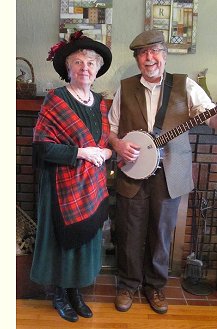
Shelia, who has costumed many plays over the years, visited one of her favorite costume sources (a thrift shop in Dayton) brought home several tweed jackets about my size with the idea of cutting one of them down into a vest. She also found me a tweed “Newsies” cap from Donegal. The jacket we loved the best – which might have suited me as a real item of clothing, had a moth hole on one shoulder, so we didn’t feel too bad about chopping it up. Shelia did a practice she’s done for dozens of musical productions where people needed old-fashioned-looking vests (think Fiddler on the Roof). She cut off the sleeves, widened and hemmed the “arm holes,” and pegged the lapels so they’d look smaller. She also folded down the collar on one of my old cotton dress shirts and whip-stitched it in place so it looked like a collarless shirt. I dug out a pair of faded black Dockers that I figured would pass for early 20th-century work pants in a pinch (since my vest would hide the back pocket, etc.). Technically, I should have had suspenders, but my last good pair disappeared years ago, and you wouldn’t be able to see them under the vest anyway.
Then my sister Tess, who loves Folk songs and has period clothing she uses for Christmas caroling, was able to join me. So she came down from Michigan a day early, and we practiced several songs, including some Folk songs we used to sing together as children.
The evening of the event, we arrived plenty early, to discover that the event managers were having to scramble a great deal. At least one of the “historical figures” had a crisis and couldn’t show up. Several of the “minor characters” got shuffled around to cover, and so on. So the direction for us was something on the order of “figure it out for yourselves.” 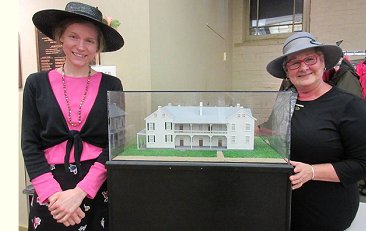 We would be standing in the main lobby (a 40’x50′? open area with okay acoustics).
We would be standing in the main lobby (a 40’x50′? open area with okay acoustics).
Only one other group was camped out there already, a table with information about “Pennsylvania House,” an old inn that had been built along the West National Road nearly two centuries go, and which has been very nicely restored. The photo to the right, as well as the rest of the photos on this page are courtesy of the Clark County Historical Society’s Facebook page
I had been warned that any music we did would have to be in between “the dancers,” whatever that meant. Well, “the dancers” showed up. 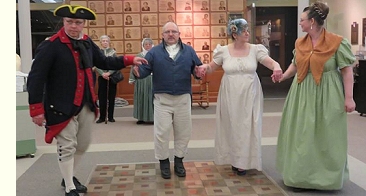 Turned out that they were part of the “Liberty Dancers” troupe, who perform Regency-era dances at the Fair at New Boston every year. They’ve been doing this a while, so they settled in and practiced their setup once. For music they had a recording of what I would guess was a late 18th-century dance piece that seemed to be on one of their cell phones, being broadcast to one of those Bluetooth speakers. The fellow operating the cell phone had white gloves on as part of his costume, which made operating the cell phone interesting – the phone’s touch-screen couldn’t pick up his “gestures” through the gloves. As the night wore on, he finally lost the gloves altogether. The song also went on longer than their dance – they hadn’t had time to get the sound file edited. So after they took their final positions and bowed, the man with the phone would stop the tune as quickly as he could. Apparently they usually have a small ensemble supporting them when they play at the Fair at New Boston, so the music going on too long is not usually a problem. (Guys, if you read this, contact me and I’ll help you edit your tunes to the right length for this sort of thing.)
Turned out that they were part of the “Liberty Dancers” troupe, who perform Regency-era dances at the Fair at New Boston every year. They’ve been doing this a while, so they settled in and practiced their setup once. For music they had a recording of what I would guess was a late 18th-century dance piece that seemed to be on one of their cell phones, being broadcast to one of those Bluetooth speakers. The fellow operating the cell phone had white gloves on as part of his costume, which made operating the cell phone interesting – the phone’s touch-screen couldn’t pick up his “gestures” through the gloves. As the night wore on, he finally lost the gloves altogether. The song also went on longer than their dance – they hadn’t had time to get the sound file edited. So after they took their final positions and bowed, the man with the phone would stop the tune as quickly as he could. Apparently they usually have a small ensemble supporting them when they play at the Fair at New Boston, so the music going on too long is not usually a problem. (Guys, if you read this, contact me and I’ll help you edit your tunes to the right length for this sort of thing.)
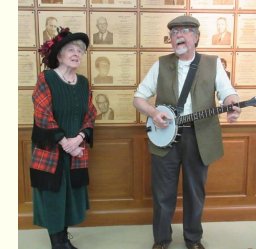 Tess and I took a quick walk through the museum, but none of the “historical characters” were settled in yet. Then we came back to the main lobby, positioned ourselves against one of the walls and started playing music. Then the dancers practiced again. Then we played some more songs. Our song list included mostly traditional pieces like “Worried Man Blues,” “Greenland Whalers,” and “The Water Is Wide.” When we had a longer patch to fill, I would throw in a couple originals in the same style, and twice resorted to “City of New Orleans,” which was anachronistic, but I was the only person in the building who knew it. A couple of times we got a sing-along going on “I’ll Fly Away.”
Tess and I took a quick walk through the museum, but none of the “historical characters” were settled in yet. Then we came back to the main lobby, positioned ourselves against one of the walls and started playing music. Then the dancers practiced again. Then we played some more songs. Our song list included mostly traditional pieces like “Worried Man Blues,” “Greenland Whalers,” and “The Water Is Wide.” When we had a longer patch to fill, I would throw in a couple originals in the same style, and twice resorted to “City of New Orleans,” which was anachronistic, but I was the only person in the building who knew it. A couple of times we got a sing-along going on “I’ll Fly Away.”
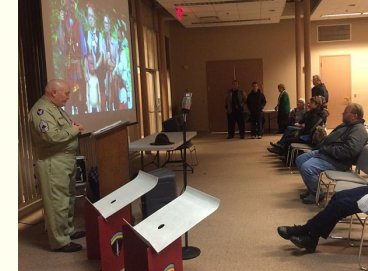 After we and the dancers had taken turns practicing a while, the visitors started arriving. Once they had bought or shown their tickets, they were ushered to a large (25’x40′?) meeting room where I am told that they they were shown a presentation and a fellow dressed in WWII gear talked, sang WWII-era songs, and answered questions until the tour was about to begin. I learned later that, like the dancers, he is also active in the Fair at New Boston, in Colonial-era gear, though.
After we and the dancers had taken turns practicing a while, the visitors started arriving. Once they had bought or shown their tickets, they were ushered to a large (25’x40′?) meeting room where I am told that they they were shown a presentation and a fellow dressed in WWII gear talked, sang WWII-era songs, and answered questions until the tour was about to begin. I learned later that, like the dancers, he is also active in the Fair at New Boston, in Colonial-era gear, though.
Since Tess and I were “winging it,” it took us a tour or two to figure out what the “drill” was. As each tour was brought out of the “waiting room,” the dancers would do their dance, with the tour guide explaining who they were and what they were doing. Then the tour guide would take the group past the Pennsylvania House table, give a short explanation there, then lead them into the museum proper. This happened about nine times.
At first we didn’t know the drill, but eventually we figured out how it worked. One of the dancers would look down the hall to see when the next batch was coming so they could take their positions. I would take that as a sign to “wrap up” whatever song we were doing. When the next tour group was mostly in the hall, the dancers would start their song.
After a few iterations, I realized that the dancers’ music wasn’t loud enough to get all of the visitors’ attention right away. Each dance was only about a minute long, so folks who didn’t realize what was going at first, would miss most or all of it.
So I started tapping out the beat on the head of my banjo, the sort of thing a frontier orchestra or military band might have done in that era anyway. That seemed to make the visitors look around to see where the sound was coming from and notice the dancers. Later on, the dancers told me “Thanks;” they thought it helped.
I also watched to see when the dance was actually ending (as opposed to when they got the music shut off). Tess and I would start clapping as soon as they struck their last position, which got the visitors to start clapping, too, which also helped.
Then, as the tour group went past the Pennsylvania House display, I would move to a more distant corner and play some banjo tunes quietly as background music. Once the group had moved into the museum, Tess and I would return to our original position and start singing again. We did this for three hours. Technically, I probably only played banjo (including background music) for about two hours, and we only sang for about an hour and a half of that. But when we were done, we were done.
During the course of the evening the younger woman who was helping at the Pennsylvania House table said she liked my banjo playing. She told me that her family had a Bluegrass band. From that point on, I was merciless about insisting she join our sing-a-longs. 
The event managers had directed us to the snack room, and we took advantage of it a couple times. After the last tour went through, I visited it a little more vigorously, chatting with the other folks who were done with their historical figure impersonations, including Teddy Roosevelt, Orville Wright, and the World War II soldier.
Then we went upstairs where the members of the Springfield Dulcimer Club had already been playing since early in the evening. One of the leaders saw my banjo case and invited me to join, but I declined as politely as I could. Tess and I listened for about twenty minutes and had some great home-made cookies that volunteers had provided, then decided to head for home.
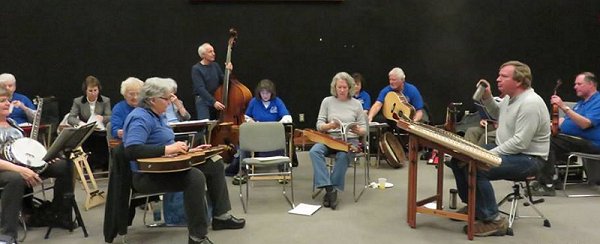
On our way out, we were invited to go back up for the group photo, but I was too tired to go back up the stairs one more time. In retrospect, we should have gone because it would have been nice to have the remembrance. Maybe next year?
Now that I “know the drill,” I would be very glad to do this again. I’m also happy to report that, though my voice was “iffy” by the end of the night, I didn’t develop serious blisters on my fingertips. The Backless Goodtime Classic Special, with its tone ring, had just the right amount of “chime” for the room. I hear that Deering is upgrading that line with more durable staining and fancier engraving on the fingerboard and fancier marking on the peg head. I hope it doesn’t raise the cost too much, not that I need another banjo as long as I have this one (and several others).
Tess and I didn’t exactly put on a professional concert – sometimes we had to remind each other how the next verse started, or sang different words to a Folk song verse I remembered one way and she remembered another way. But that’s the way home-brewed music has always worked, and I think we came across as authentic, if nothing else. 🙂
Now that I write this up, I really, really wish, someone had taken a video or made a recording of anything we did, to give a better idea, not only of how we sounded, but also of how much fun we were having. Outside of Christmas caroling, Tess and I hadn’t sung together in front of people for maybe 45 years. We definitely have to fix that. Again, if anyone reading this has photos, videos, etc., please use the contact page of this site to let me have your contact information.
Finally, I really like the look of the vest Shelia made me. Since I usually wear “Newsie” hats anyway, that wouldn’t be too much of a stretch to add to my performing wardrobe. 🙂
Here’s hoping you all get a chance to something at least halfway as fun and creatively fulfilling this week!





